Master the Art of Speedy & Healthy Pad Thai Zoodles: Behind the Scenes with a TV Food Personality
Ever wondered what goes into creating those seemingly effortless cooking segments on television? As a regular guest on “Daytime TV,” I get to experience the exhilarating, fast-paced world of live-to-tape culinary demonstrations firsthand. But beyond the bright lights and bustling studio, there’s a valuable lesson in adaptable cooking that I bring back to my kitchen – a lesson perfectly embodied in this vibrant and delicious Pad Thai Zoodles recipe. This article not only pulls back the curtain on my TV cooking adventures but also equips you with the secrets to crafting a truly incredible, healthy, and easy-to-make Pad Thai Zoodles dish that’s perfect for any weeknight meal.
Lights, Camera, Cooking! A Glimpse into the Daytime TV Studio
Stepping into the “Daytime TV” studios is always an adventure. It’s a show that reaches nearly 200 markets across the US, hosted by the delightful Cyndi Edwards and the incredibly funny Jerry Penacoli (whom you might recognize from EXTRA). My cooking segments are typically around four minutes long, a tight timeframe that demands precision, quick thinking, and a good dose of humor. We tape the segment, and then it’s usually aired two or three days later, depending on the market’s schedule.
The studio itself is an impressive, sprawling space. Below, you can see a peek at just the back half – it gives you an idea of the sheer scale. Every inch of the ceiling is a labyrinth of cables, supporting a complex array of lights, speakers, and other equipment essential for broadcast. It’s a fascinating, organized chaos that underpins every show.

From another angle, the technical infrastructure is even more apparent. I’m always amazed by the intricate network of cables hanging overhead, a testament to the meticulous planning required for television production.

Standing in the kitchen set, looking out towards the cameras, it’s a unique experience. There are three cameras focused on the cooking action, but my gaze isn’t usually fixed on them. Except for a quick “hello” at the beginning and a “goodbye” at the end, my focus is firmly on the food and engaging in lively conversation with the co-host. This approach makes the segment feel more natural and allows me to truly immerse myself in the culinary process.
A typical cooking segment is structured into four distinct parts:
- Hello (Introduction and greeting the audience/hosts)
- Demo/Cook (The main cooking demonstration)
- Taste (The delicious moment of sampling the finished dish)
- Goodbye (Farewell remarks)
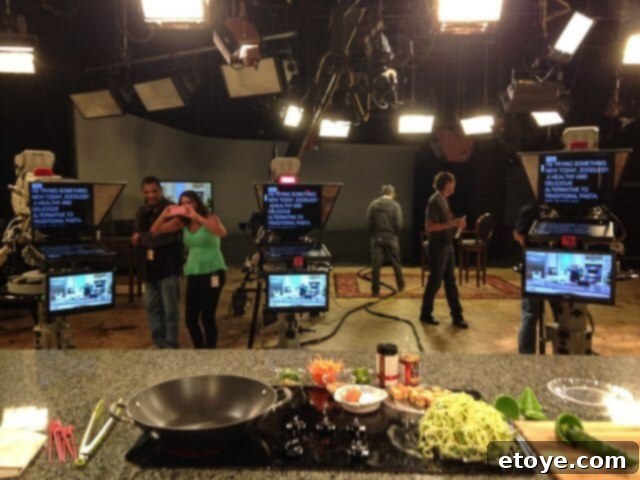
Just because I’m not directly looking at the camera doesn’t mean I ignore them. Quite the opposite! My peripheral vision is constantly scanning for the red light that indicates which camera is live, ensuring I’m always aware of what the audience sees. When it’s time to showcase a particular step or ingredient, I’ve learned to pause, ensure the camera has a clear shot, and hold my hands steady while continuing to talk. This simple technique prevents viewers from getting dizzy trying to follow my movements, creating a smoother and more enjoyable viewing experience.
Embracing Imperfection: The Art of Live-to-Tape Cooking
One of the most defining aspects of “Daytime TV” is its live-to-tape format. This means “time over is time over.” There’s no re-recording or “cutting” unless there’s a technical glitch with a camera. Even if I make a culinary mistake or don’t finish cooking on schedule, there are no do-overs. This high-stakes environment has been an invaluable teacher, training me to let go of the quest for perfection and embrace the beauty of authenticity.
For instance, if you happened to catch my Pad Thai Zoodles segment, you might have noticed a couple of humorous “oopsies.” Not only did I momentarily forget an ingredient (cilantro!), but I also created a rather massive mess while attempting to plate the zoodles. Instead of panicking, Cyndi and I simply shared a laugh about it on camera and moved on. These unscripted moments make the show feel incredibly natural and relatable, reinforcing that cooking, both on TV and at home, is about enjoyment and adaptability, not flawless execution.
There’s no teleprompter for the cooking segments, only for the intro and exit. This encourages genuine interaction and allows for spontaneity. To ensure we finish on time, I’ve developed a mental exercise: walking through the recipe backward. This helps me identify what ingredients need to be prepped or pre-cooked. For this Pad Thai Zoodles recipe, for example, I pre-cooked the tofu and pre-spiralized the zucchini (or “zoodles”) so a batch was ready for the wok. This way, I could start cooking while Cyndi was demonstrating the spiralizer, the amazing Paderno 4-Blade Spiralizer.
When the floor director, Rob, signals two minutes remaining, and I know there’s no way to finish, I have a few strategies. I’d either cut out minor steps or ingredients, ensuring there’s still something ready to taste. Just kidding about freaking out! One memorable time, the chicken in a dish wasn’t fully cooked when it was “taste” time. Thinking on my feet, I told Jerry, “Jerry, we’re running out of time, the chicken needs a couple more minutes. But here, grab a fork and try the vegetables and sauce!” We proceeded to taste everything but the chicken, and Jerry still had plenty to say about the flavors for the camera. Hopefully, no one got salmonella or gastroenteritis from that!
The Dish That Wowed On-Air: Irresistible Pad Thai Zoodles
Enough about the glitz and glamour of TV! Let’s get to the star of the show: the food! This incredible Pad Thai Zoodles recipe was what I whipped up on air. Due to my kitchen being under renovation, I even had to recreate it for the photoshoot on a small camping stove in my backyard – less than a week before getting a real kitchen back, thankfully!
As a side note, my cilantro often looks suspiciously parsley-ish. We grow both, and I sometimes wonder if they cross-pollinate, leading to a new herb I’ve dubbed “Cilantrey” or “Partro.” My friend Cheri, however, has a more direct name for it: “You-Ruined-The-Parsley.” Either way, fresh herbs are key to this dish!
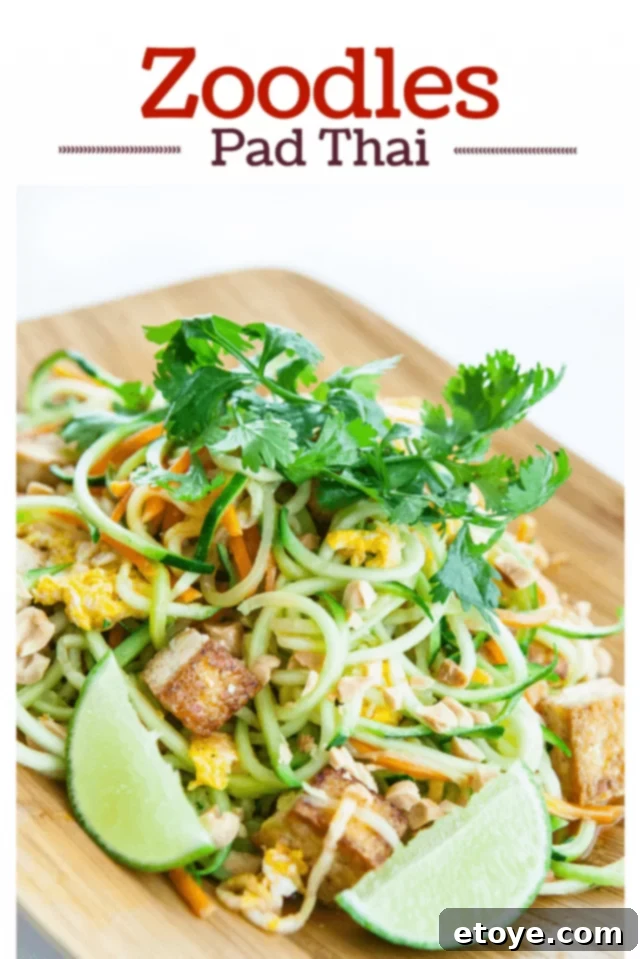
JERF Principles: Just Eat Real Food for a Healthier You
The core philosophy behind many of my recipes, including this one, is “JERF” – Just Eat Real Food. This principle emphasizes consuming whole, unprocessed ingredients. Let’s break down how this Pad Thai Zoodles recipe aligns with JERF:
JERF-Approved Ingredients:
- Tofu
- Eggs
- Green Onion
- Garlic
- Ginger
- Carrots
- Zucchini
- Lime
- Peanuts
- Cilantro
Not-JERF (But Used Strategically):
- Thai Kitchen Pad Thai Sauce (we only use 3 tablespoons)
(Note: I’m still researching cooking oils to place them definitively in a JERF category.)
I don’t shy away from using prepared sauces or other shortcuts, especially if the “JERF” column of ingredients is substantial. This recipe serves four, so three tablespoons of a pre-made sauce is a small amount distributed across multiple servings, making it a perfectly acceptable compromise for convenience without sacrificing the overall health benefits. However, if you’re a strict JERF enthusiast and prefer to make everything from scratch, I highly recommend checking out Todd and Diane’s version of Pad Thai Zoodles, which features a homemade sauce crafted from ketchup, fish sauce, vinegar, and other fresh ingredients.
The beauty of this Pad Thai Zoodles recipe lies in its simplicity and the abundance of fresh vegetables. Zucchini noodles are a fantastic low-carb, gluten-free alternative to traditional rice noodles, allowing you to enjoy the beloved flavors of Pad Thai with added nutritional benefits.
Unleash Your Inner Chef: Choosing the Best Zoodle Maker (Spiralizer vs. Julienne Peeler)
A key component of this recipe, and indeed a staple for healthy, creative cooking, is the “zoodle” machine, also known as a spiralizer. The one I used for this recipe, and highly recommend, is the Paderno 4-Blade Vegetable Spiralizer.
I previously reviewed an earlier model, the Paderno 3-Blade, and compared it with other options in a Spiralizer Review Video. This newer 4-Blade model takes it a step further. It includes an extra blade for creating delicate angel hair-sized zoodles, and a metal rod that allows you to make fun, carnival-style potato chips on a stick. It’s a versatile tool that opens up a world of culinary possibilities beyond just zucchini noodles.
The Paderno 4-Blade Spiralizer is priced at $49.95 on Amazon and is a fantastic investment if you plan on regularly incorporating spiralized vegetables into your diet. However, if you anticipate making zoodles only occasionally, you might consider one of my most-used kitchen tools: the Oxo Julienne Peeler, which costs around $10. It’s much smaller, fits easily in a drawer, and is a budget-friendly option for creating beautiful vegetable strands without committing to a larger appliance. Both tools are excellent for transforming vegetables into fun, nutritious noodle alternatives.
Crafting Perfect Pad Thai Zoodles: A Step-by-Step Guide
Now, let’s dive into the cooking process for these delightful Pad Thai Zoodles. Success lies in understanding the nuances of stir-frying and ingredient timing.
The Secret to Crispy Tofu
I am an absolute lover of crispy-crunchy tofu. To achieve that perfect texture, it’s crucial to cook the tofu separately and remove it from the pan before adding the sauce and vegetables. This prevents the tofu from becoming soggy and ensures each piece maintains its satisfying crispness. Simply toss the cubed tofu in a little oil, add it to a hot wok, and brown each side for 1-2 minutes. This initial step is worth the extra few minutes.
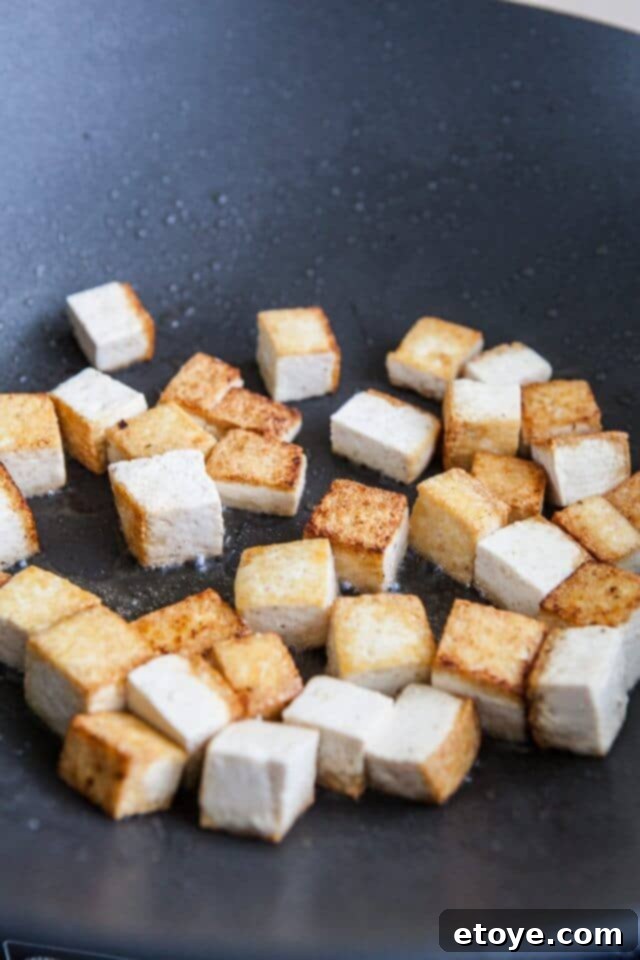
Once browned, remove the tofu from the pan and set it aside.
The Egg Dilemma: Why Cook Separately?
Next up, the eggs! Our hens lay eggs with yolks so bright, vivid, and vibrant, they truly elevate any dish.
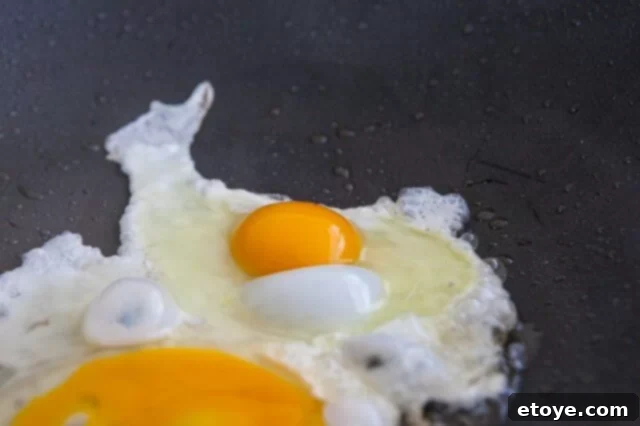
Give them a good scramble, then also remove them from the pan.

You might wonder why remove the eggs? Here’s the reasoning:
- I prefer my eggs to be perfectly cooked, firm, and distinct from the rest of the stir-fry.
- If cooked first, then everything else is added, the eggs would inevitably overcook. Furthermore, the “everything else” would be drowned by the moisture from the eggs, preventing them from frying properly and developing their own flavor in the cooking oil. Eggs, you see, are oil-hoggers!
- Conversely, if all the vegetables are cooked first and then raw egg is added, it would simply coat the vegetables, creating a giant, soggy mess.
An alternative method could be to cook the aromatics (ginger, garlic, green onion), then the carrots, then zucchini. Then, make a large hole in the center of the wok, add a bit of oil, and scramble the eggs in that empty space. Once the eggs firm up, thoroughly mix all the stir-fry together. HOWEVER, zucchini noodles cook incredibly fast. They are best cooked about 80% of the way to retain some texture and bite. Soggy, overcooked zucchini quickly becomes watery and unappetizing. So, to be on the safe side and ensure optimal texture for the zoodles, I cook the eggs separately. You’ll see them reintroduced into the pan at the perfect moment later on.
Building the Flavor Base
Once the eggs are out, use a paper towel to give the wok a quick wipe. Swirl in a tiny bit of the remaining cooking oil and add the aromatics: ginger, garlic, and green onion. Stir-fry for about 15-30 seconds until they become incredibly fragrant. This step is crucial for building a deep flavor foundation.
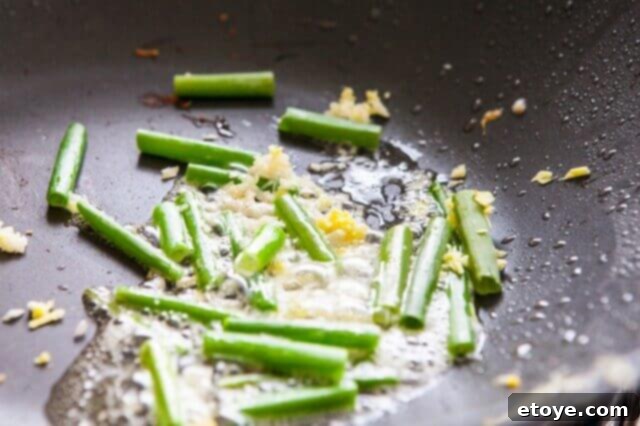
This is also why we only use three tablespoons of the prepared Pad Thai sauce, rather than the entire jar. We’re intentionally enhancing the “aromatics” and infusing the dish with robust flavor from fresh garlic, ginger, and green onion, allowing the sauce to complement rather than overpower.
Perfectly Cooked Vegetables
Add the matchstick-cut carrots to the pan and stir-fry for about a minute. Note: I didn’t use the Paderno Spiralizer for these carrots. My local store carries thinner organic carrots, and for effective spiralizing, carrots need to be quite thick. This is where buying pre-cut vegetables can be a time-saver! Carrots take longer to cook than zucchini, so adding them first is key. The secret to successful wok cooking is knowing the correct timing for each ingredient. If I had added the zucchini at the same time as the carrots, the zucchini would be overcooked by the time the carrots reached their ideal tenderness.

Now, add in the star of the show: the zucchini zoodles.
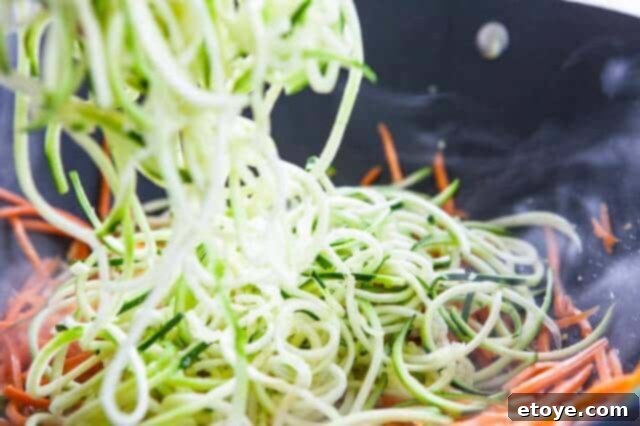
Toss them very well and let them stir-fry briefly until you notice their color changing from opaque to just slightly translucent. Zucchini cooks incredibly fast, so this won’t take long – usually around a minute. The goal is to cook them just enough to soften, but still retain a pleasant al dente texture.
Bringing It All Together
Add the Pad Thai sauce. I use Thai Kitchen Pad Thai Sauce, which is gluten-free and dairy-free, but does contain fish sauce, so it’s not suitable for vegetarians. It tends to be on the sweeter side, so if you crave more savory or salty flavor without additional sweetness, a few sprinkles of fish sauce or soy sauce can be added to taste.

Finally, return the crispy tofu and scrambled eggs to the pan. Toss everything together vigorously, ensuring the sauce coats every ingredient evenly. Cook for another two minutes, allowing all the flavors to meld beautifully. Taste and adjust the seasoning, adding more Pad Thai sauce if you prefer a sweeter or more intense flavor, or fish/soy sauce for saltiness.
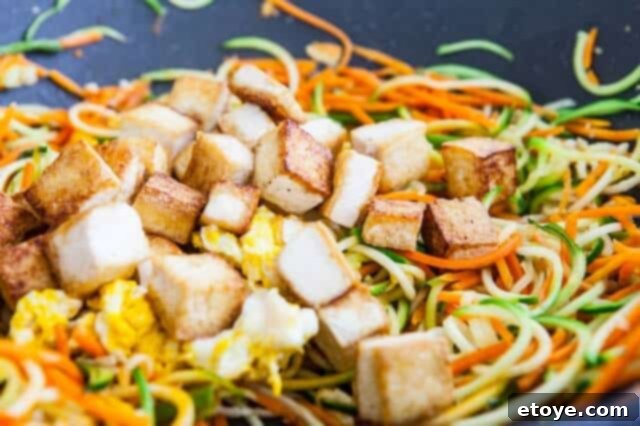
To finish, squeeze in some fresh lime juice for a bright, zesty kick. Toss again, then garnish generously with chopped peanuts and minced cilantro. Serve immediately with extra lime wedges and a dash of your favorite hot sauce for those who enjoy an added kick!
Elevate Your Dish: The Power of Sriracha Seasoning
On the TV segment, I incorporated a fantastic new product I discovered: Rodelle Sriracha Seasoning. This innovative spice blend truly takes flavor to the next level!
It delivers an explosion of spice, garlic, salt, sweetness, and tanginess all in one. When Cyndi and I did our on-air “taste test,” we both exclaimed “WOW!” It truly adds a powerful punch of flavor to any dish.
The good news is that the ingredients are easy to pronounce: sugar, salt, spices, garlic, vinegar powder (maltodextrin + distilled white vinegar), citric acid, and soybean oil. While sugar is listed as the first ingredient, remember that it’s a seasoning, and you’re typically only using about 1/4 teaspoon per serving, so the overall sugar contribution is minimal.
I can’t wait to experiment further with this Sriracha seasoning. It would be amazing as a dry rub for shrimp on the grill, or really, anything grilled! I’m also confident it would add a wonderful depth of flavor to a roast. It’s a versatile spice blend that deserves a spot in your pantry for instant flavor boosts.
Essential Tools for Your Pad Thai Zoodles Journey
To help you create your own delicious Pad Thai Zoodles and other healthy dishes, here are some of the essential tools I use. Thank you for supporting me by using my affiliate links!
-
The Magical Paderno Zoodle Machine: My go-to for perfectly spiralized vegetables.
Get the Paderno 4-Blade Spiralizer here.
(You can also watch my video review of different spiralizers here.) -
The Highly Recommended Oxo Julienne Peeler: My love for this tool knows no bounds for quick and easy julienned vegetables.
Find the Oxo Julienne Peeler here. -
The Sriracha Spice Blend: For an explosive burst of flavor!
Discover the Rodelle Sriracha Seasoning. -
My Favorite Wok: Essential for perfect stir-frying.
Check out my favorite wok.
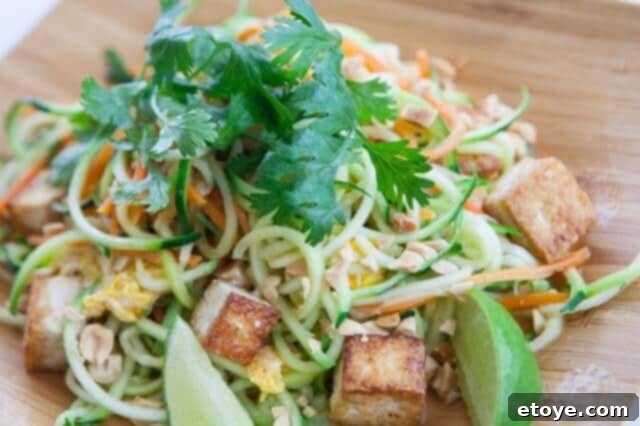
Pad Thai Zoodles
Ingredients
- 8 ounces extra firm tofu, cubed
- 2 tablespoon cooking oil, divided
- 2 eggs, beaten
- 1 stalk green onion, cut into 2″ lengths
- 1 clove garlic
- 1 teaspoon fresh grated ginger
- 1 cup matchstick cut carrots
- 3 large zucchini, cut into noodle spirals
- 3 tablespoons prepared Pad Thai sauce (or more, depending on taste)
- 1 lime, halved (use 1 half for step 5, cut other half into wedges for serving)
- 1/4 cup chopped peanuts
- sprigs of cilantro, minced
Instructions
- Pat the tofu very dry with paper towels. Toss just 1 tablespoon of the cooking oil with the tofu. Heat a wok over high heat. When hot, carefully slide the tofu (be careful of any splatters). Brown all sides of tofu, about 1-2 minutes each side. Remove tofu to plate and set aside.
- With a paper towel, wipe the wok clean. Swirl in just half of the remaining cooking oil and turn the heat to medium-high. When hot, add in the eggs and scramble. Remove the eggs to the tofu plate and set aside.
- Return wok to medium-high heat. Swirl in the last of the cooking oil and turn heat to medium-high. When hot, add in the green onion, garlic and ginger. Cook for 15 seconds, until fragrant.
- Turn heat to high and add in the carrots. Toss and stir fry for 1 minute. Then add in the zucchini noodles. Toss well and when zucchini begins to soften (about 1 minute), then stir in the Pad Thai sauce. Add in the eggs and the tofu. Toss, cook for 2 minutes. Taste and add additional sauce if desired.
- Squeeze a little lime on top, top with chopped peanuts and cilantro. Serve with additional lime wedges.
There you have it – not just a recipe, but a journey from the bustling TV studio to your own kitchen. This Pad Thai Zoodles recipe is a testament to how quick thinking, strategic meal prep, and a little embrace of imperfection can lead to truly delicious and healthy results. Whether you’re aiming for a low-carb, gluten-free meal or simply want a fresh take on a classic, these zucchini noodles deliver on flavor and nutrition.
I hope this behind-the-scenes look inspires you to get into your kitchen, experiment, and perhaps even laugh at your own culinary mishaps. Cooking should be an enjoyable and rewarding experience. So, grab your spiralizer, whip up a batch of these amazing Pad Thai Zoodles, and let me know how it goes in the comments below!
